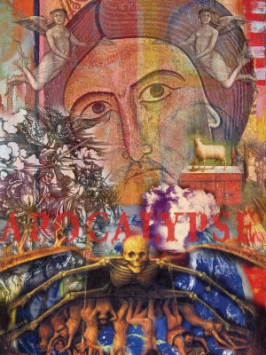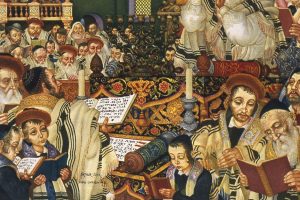Joyce Donahue first became aware of the popularity of the Rapture belief among Catholics a few years ago when a catechist at St. Charles Borromeo Parish in Hampshire, Illinois told her about "all the wonderful things he was teaching his seventh-grade class about the Rapture."
The catechist was one of the millions of Americans who have read books in the phenomenally successful Left Behind series. (Its publisher, Tyndale, claims almost 65 million copies sold.) The 12 techno-thrillers-cranked out between 1995 and 2004 by Tim LaHaye and Jerry Perkins and supplemented by movies and a 40-volume children's book series-have popularized the dispensationalist end-of-the-world scenario. A long-time staple in the fundamentalist movement, it is also pushed by influential mega-church preachers and televangelists.
Despite its long-running anti-Catholic streak-the Catholic Church is often identified with the "Whore of Babylon" and Catholics are generally not seen as "real Christians"-the dispensationalist movement's inroads into Catholic parishes such as St. Charles aren't isolated incidents.
"Many Catholics have interiorized this," laments Donahue, the associate director of the Religious Education Office in the Diocese of Joliet, Illinois. Even though the Left Behind books are not as prevalent as they were a few years ago, the end-time scenario they preach is "still swirling around in the culture," she says. "Some people don't know that this isn't part of what we teach in the Catholic Church."
Donahue helped write a 2003 statement by the Illinois Catholic bishops that denounced the Left Behind series as "one of the most attractively marketed recent false ‘prophets' " and as being both anti-Catholic and "in conflict with Catholic teaching." The Rapture ideology, the statement said, promotes "an unhealthy and immature belief in a harshly judgmental God."
The dispensationalist end-time scenario is a modern-day version of "millenarian" beliefs (the term refers to the "1,000 years" of Revelation 20:1-6) that have sprung up at various times in church history. The 19th-century British preacher John Nelson Darby is credited with coming up with the scheme. Darby's particular new twist was his introduction of the concept of the Rapture, which breaks the Second Coming of Christ down into two stages: the mid-air Rapture of born-again believers at the beginning of the seven-year Tribulation and what really amounts to a "third coming" after the Tribulation.
The Rapture idea is based on creative but erroneous interpretations of three Bible passages (1 Thess. 4:13-18, Matt. 24:40-41, and John 14:1-2). In a desperate attempt to cling to a supposedly "literal" approach to interpreting the Bible, the proponents of the Rapture engage in an absurd "biblical hopscotch" by isolating and then re-assembling snippets from very different biblical books.
But they don't fool Joy Hoelscher in San Angelo, Texas, who recalls an encounter with two proselytizers at her home. "They wanted to know if Catholics take the Bible literally, and I said, ‘Some of it we do, and some of it we don't. You have to understand when it was written, and who it was written for, and their culture and the way they talked, and then you'll understand what a particular Bible passage means.'"
As New Testament scholar Barbara Rossing documents in her thorough repudiation of dispensationalism, The Rapture Exposed: The Message of Hope in the Book of Revelation (Basic Books), the dispensationalists' claim that they take the Bible literally flies in the face of their own arbitrary decisions to take some of the apocalyptic imagery in the Book of Revelation, for example, literally and other images not.
"The moon only ‘looks like' it turns to blood in Left Behind-apparently not a literal image," Rossing notes. "Yet in the very same chapter LaHaye insists the world's seas and rivers must literally turn to blood." A not-so literal reading also allows dispensationalists to interpret the elements that melt with fire in 2 Peter 3:12 as a biblical "description" of nuclear war or the two wings of the eagle in Revelation 12:14 as a military helicopter.
What is troubling about the popularity of the Rapture theology is that it has led far too many Christians to believe in what Rossing calls a "shoot-'em-up Terminator type of Jesus who comes back to kill all the bad guys and blow up the world."
In their eager pursuit of their end-of-the-world prophecy scheme, dispensationalists often seem almost dismissive of Christ's first coming, and are instead looking forward to what amounts to a reversal of Jesus' Good News.
John Hagee, the dispensationalist preacher from San Antonio whose anti-Catholic and anti-Semitic comments caused a stir during the 2008 presidential election campaign, contrasts the two comings this way: "The first time he came to earth, Jesus was the Lamb of God, led in silence to the slaughter. The next time he comes, he will be the Lion of Judah who will trample his enemies until their blood stains his garments, and he shall rule with a rod of iron."
Similarly exasperated with the Sermon-of-the-Mount, love-thy-enemies Jesus of the gospels, one of the most prominent dispensationalist theologians, the late John F. Walvoord, looked forward to the day when the "quiet manger scene" of the first coming will be replaced by "a mass carnage" of all but born-again Christians. That kind of ultimate schadenfreude may be good for book sales, but it seems diametrically opposed to the Good News that Christianity is all about.
In The Rapture Exposed, Rossing writes, "God is coming to heal the world, not to kill millions. . . . Love and healing-not Armageddon and war-are the messages people of faith must keep lifting up as God's vision for the world."
This article appeared in the December 2009 issue of U.S. Catholic (Vol. 74. No. 12, page 20).
Related:
"Ready or not, here I come…again,"
Rapturing books: Read more on the end times














Add comment